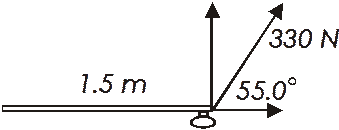Torque
Torque
The following text is used only for teaching, research, scholarship, educational use and informative purpose following the fair use principles.
We thank the authors of the texts and the source web site that give us the opportunity to share their knowledge
Physics
Torque
Lance furrowed his handsome, intelligent brow, and carelessly wiped the glistening pearl-shaped beads of perspiration from his noble forehead as he examined the blinking data display of his Plasmo Mark 22 Magnetotronic Force Field sensor. His intelligent, hard yet sensitive eyes peered into the darkness of the impact crater that lay just in front of his all six-wheel drive fusion powered terrain hoover-scout vehicle. Somewhere hidden in the Stygian blackness of that vast space was his arch enemy, Zugandor the Fierce, and his cruel minions. Lieutenant Lance paused as he considered the dilemma he and his space companion, Ardella Lamont, now faced. The dreaded battle battalion of Bokonia had somehow caught up with Lance and Ardella in the backwater asteroid worlds of the Altair seven systems. Before the third moon of Casoobo could set, Ardella and Lance might well be dead.
“Lance, how did Zugandor manage to find us?” Ardella asked. “I thought we would be free when we left Tachron seven via the quantum anti-muon drive of your star cruiser.” She ran her tapered, delicate fingers through the long red locks of her ravishing curly hair and bit her full, heartshaped, sensitive lips.
“Blast! They must have come up with a way to detect the Fermian field generated by our hyperspace warp drive! Zounds! I think we’re in a hot spot.”
“Lance, have I ever told you how much you mean to
Oops: Oh dear, there has been some kind of dreadful data file mistake. The Physics Kahuna apologizes for the previous stuff that you just read through. Apparently part of a file for his hugely popular, award winning soon-to-be-published third novel in the Lieutenant Lance Lightning, Space Ranger trilogy (a movie deal with Dreamworks is in negotiations) got copied into this, a fine non-fiction educational work on AP Physics – that most important of subjects. Probably by the underpaid secretary employed by the Kahuna Physics Institute. Well, rest assured that she has been discharged! Such sloppy work will not be tolerated!
How could this happen? Is it sheer incompetence displacing professional performance as it has so many times before? Well, frankly, the Physics Kahuna simply does not know. But this he promises, he will try to make sure it never happens again!
Forces: We’ve learned that forces change the velocity of an object. But what does it take to change the angular velocity of a thing? Well, forces are involved, but the force has to be applied in a special way. We call this special applied force a torque.
There are many ways to apply a force to a system that can rotate. In the drawing below we have a turntable that can spin. If we just push sideways on the thing, as in the drawing to the left, we will not make it spin. We basically would be trying to tip it over. But if we apply a force tangent to the disc as in the drawing to the right, it will spin. This force is perpendicular to a radius of the circular path. A force that is applied perpendicular to the circular path at some distance from the spin axis is called a torque.
 |
Torques change angular velocity. The symbol for torque is the Greek letter t. Torque is given by this equation:
![]()
r is the distance to the center of spin from where the force is applied. This variable is often called the lever arm.

F sin q be the force component that is perpendicular to the lever arm.
If the angle q is 90°, then the force is perpendicular to the lever arm, the sine is one, and the equation for torque is simply:
![]()
Note for some unknown reason, the force is written first and then the lever arm in this equation.
You can see that the unit for torque is going to be a newton meter (nm). We leave it like that. This looks very similar to the unit for work, the joule, but it is quite different. So energy and work are in joules and torque is left in newton meters.
Torque is a vector quantity.
- 125 N is applied to a nut by a wrench. The length of the wrench is 0.300 m. What is the torque?
|
![]()
- A torque of 857 Nm is applied to flywheel that has a radius of 45.5 cm. What is the applied force?

- You push on the door as shown in the drawing. What is the torque?

![]()
![]()
![]()
Multiple Torques: What happens if two or more torques act on an object at the same time?
 Two forces are applied to the object in the drawing to the right. The object is free to rotate about the spin axis. Both cause a torque.
Two forces are applied to the object in the drawing to the right. The object is free to rotate about the spin axis. Both cause a torque.
F1 causes a CCW (counter clockwise) rotation around the axis.
F2 causes a CW (clockwise) rotation around the axis.
If a torque causes a clockwise rotation, it is positive.
If a torque causes a counter clockwise rotation, it is negative.
The sum of the two torques would be: 
Equilibrium and Torque:If an object is in angular equilibrium (sometimes called rotational equilibrium), then it is either at rest or else it is rotating with a constant angular:
If object is in rotational equilibrium, the net torque about any axis is zero.
This means that the sum of the torques acting on the object must be zero.
åt = 0
Static equilibrium exists when an object has no motion, either linear or angular. There are two conditions which must exist in order to have your good old static equilibrium:
The net force must be zero and the net torque must be zero.
å F = 0
å t = 0
This gives us some very powerful tools to solve static problems. We can analyze a system and look at the forces acting on it, and we can also look at the torques that act on it. We’ll be able to do some really cool stuff.
 Two metal orbs are attached to a very lightweight rigid wire. They are suspended from a rigid point on the overhead as shown. The system does not move. Calculate the distance from the suspension line to the center of gravity on the right sphere.
Two metal orbs are attached to a very lightweight rigid wire. They are suspended from a rigid point on the overhead as shown. The system does not move. Calculate the distance from the suspension line to the center of gravity on the right sphere.
Since the system is at rest, the sum of the torques and the sum of the forces must be zero.
Let’s look at a FBD and a drawing showing the two torques:


Without using the torque equilibrium, we could not solve the problem. The sum of forces would simply tell us that the upward force would be equal to weight of the two balls.
Using torque, however, allows us to solve the problem.
All we have to do is add up d’ torques:


Torque problems, as you have just seen, are fairly simple.
Now we’ll do a classic teeter-totter beam problem.
 A teeter-totter is in equilibrium as shown. The block on the left has a weight of 625 N. The beam itself has a weight of 32.5 N. What is the mass of the second block?
A teeter-totter is in equilibrium as shown. The block on the left has a weight of 625 N. The beam itself has a weight of 32.5 N. What is the mass of the second block?
This is a pretty simple problem, we can solve it using the torques.
The sum of the torques must be zero:
å t = 0
There are three torqes, t1(from the 625 N rock) and t2 from the other rock. The weight of the beam (Fbeam), even though it has a significant amount of weight, does not cause a torque because the weight acts at the CG of the beam which is also the center of rotation. Thus the lever arm is zero.
![]()
t2 is positive (CW) and t1 is negative (CCW)

To find the mass we use the second law:

Another similar problem.

A 50.0 N seesaw supports two people who weigh 455 N and 525 N. The fulcrum is under the CG of the board. The 525 N person is 1.50 m from the center. (a) Find the upward force n exerted by fulcrum on the board. (b) Where does the smaller person sit so the seesaw is balanced?
 First, let’s draw a FBD
First, let’s draw a FBD
We know that the system is in static equilibrium, so we can analyze the forces. In the y direction, the sum of the forces must be zero.
![]()
(a) F1 and F2 are the weight of the two men, FT is the weight of the teeter-totter, and n is the normal force.
We can write this out:
![]()
Now we can solve for the normal force, this is the upward force exerted on the board by the support stand.
![]()
(b) To find the distance the second man must be positioned from the center, we must analyze the torques.
![]()
![]()

Source : http://teachers2.wcs.edu/high/bhs/mikek/AP%20Physics%20Course%20Notes/Torque/1%20-%20Torque.doc
Web site link: http://teachers2.wcs.edu
Author : not indicated on the source document of the above text
If you are the author of the text above and you not agree to share your knowledge for teaching, research, scholarship (for fair use as indicated in the United States copyrigh low) please send us an e-mail and we will remove your text quickly.
Torque
Torque
Torque
This is the right place where find the answers to your questions like :
Who ? What ? When ? Where ? Why ? Which ? How ? What does Torque mean ? Which is the meaning of Torque?
Torque physics notes
Alanpedia.com from 1998 year by year new sites and innovations
Main page - Disclaimer - Contact us
